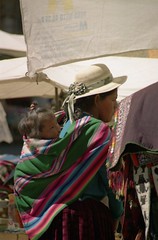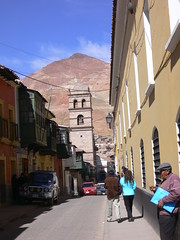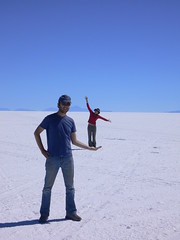Peru again (this time on purpose)
The strikes were on again yesterday morning between Copacabana and the border, much to the my dismay and that of my three companions, one English guy and two Kiwis I´d met the day before. We took a taxi to the strike zone, then had to walk the remaining 3 miles to get to the border post (me grumbling the whole way because the woman at the post office wouldn´t let me send a 4 lb package because of the strike, so I had to carry it with me). We were feeling pretty intrepid, though also quite cautious, as reports from La Paz are of strikes getting more and more violent: rioting crowds throwing rocks and dynamite and police attempting to control the demonstrations through force and frequent use of teargas, with at least two deaths as a result. Outside the big city, however, the strikes are notably calmer: we passed a very long stretch of road covered in good-sized rocks, and then found the strikers, who kindly stopped their soccer game, wished us "buenos dias" and smiled as we walked by.
We were pleased with our accomplishment as we crossed the border and soon got a bus to Puno, where we arranged a tour of the Uros, or Floating Islands, which were on strike last time I was there. These are islands made entirely of reeds and I was really happy to get to see them--pictures to come soon, hopefully. We had a quick walk around Puno, ate dinner (both the New Zealanders had alpaca) and at 8 our bus left for Arequipa, with an estimated arrival time of 2 AM.
Will I ever learn? When somebody here says the bus will take 6 hours, I should always remember to add at least 25%! (Just as when they say the bus will leave in "5 minutos, amiga!" I should always remember to add between 500 and 1000%). Thus, it should have come as no surprise that after a long, sleepless journey we pulled into Arequipa at quarter to four. Part of the delay was a bit of excitement at a police checkpoint. Four customs police officers, ominously wearing black uniforms and black masks over much of their faces (probably for the cold, but still) came on board and for some reason started roughing up one of the passengers. When this happened, many of the other passengers started shouting at the police to leave him alone, respect his rights, or else simply shouting insults. There was a baby crying and a general sense of pandemonium for about a minute. My neighbor told me that the police can pick any type of package: products that might be resold, or which might somehow be used to smuggle drugs. She told me that on a previous bus the police picked out a man who was carrying a case of shampoo, and in the tussle punched him in the face, causing him to bleed heavily from a cut on his forehead. She said that the eventual goal is to get the passenger to come inside the office and pay a "fine" for what they are carrying. So, I will be careful not to carry more than a personal amount of toiletries with me anytime I take a bus trip. Incidentally, this morning I was told one of the 20 Sole notes I had been given somewhere along the way was counterfeit...so it looks like the general sense of law and order here might have some surprises in store for me.





















